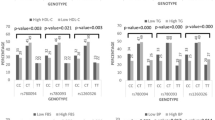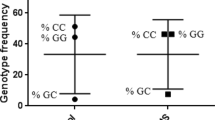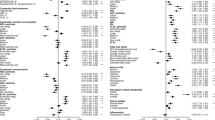Abstract
TyG (triglyceride and glucose) index using triglyceride and fasting blood glucose is recommended as a useful marker for insulin resistance. To clarify whether the TyG index is a marker for predicting metabolic syndrome (MetS) and to investigate the importance of single-nucleotide polymorphisms (SNPs) in MetS diagnosis. From 2001 to 2014, a longitudinal prospective cohort study of 3580 adults aged 40–70 years was conducted. The area under the receiver operating characteristic curves (AUROC) and Youden index (YI) was calculated to assess the diagnostic value. During the 14-year follow-up, 1270 subjects developed MetS. Five SNPs in four genes (BUD13 rs10790162, ZPR1 rs2075290, APOA5 rs2266788, APOA5 rs2075291, and MKL1 rs4507196) significantly correlated with susceptibility to MetS (p < 0.00005). The areas under the curve of TyG index and HOMA-IR were 0.854 (95% confidence interval [CI], 0.841–0.867) and 0.702 (95% CI, 0.684–0.721), respectively. Despite no statistical significance, AUROC and YI were increased when MetS was diagnosed using TyG index and the five SNPs. TyG index might be useful for identifying individuals at high risk of developing MetS. The combination of TyG index and SNPs showed better diagnostic accuracy than TyG index alone, indicating the potential value of novel SNPs for MetS diagnosis.



Similar content being viewed by others
Data availability
The data used to support the findings of this study are included within the article. All data generated or analyzed during this study are included in this published article and its supplementary information.
References
Ford ES, Li C, Sattar N (2008) Metabolic syndrome and incident diabetes: current state of the evidence. Diabetes Care 31:1898–1904. https://doi.org/10.2337/dc08-0423
Galassi A, Reynolds K, He J (2006) Metabolic syndrome and risk of cardiovascular disease: a meta-analysis. Am J Med 119:812–819. https://doi.org/10.1016/j.amjmed.2006.02.031
Guerrero-Romero F, Simental-Mendia LE, Gonzalez-Ortiz M, Martinez-Abundis E, Ramos-Zavala MG, Hernandez-Gonzalez SO, Jacques-Camarena O, Rodriguez-Moran M (2010) The product of triglycerides and glucose, a simple measure of insulin sensitivity. Comparison with the euglycemic-hyperinsulinemic clamp. J Clin Endocrinol Metab 95:3347–3351. https://doi.org/10.1210/jc.2010-0288
Matthews DR, Hosker JP, Rudenski AS, Naylor BA, Treacher DF, Turner RC (1985) Homeostasis model assessment: insulin resistance and beta-cell function from fasting plasma glucose and insulin concentrations in man. Diabetologia 28:412–419
Simental-Mendia LE, Rodriguez-Moran M, Guerrero-Romero F (2008) The product of fasting glucose and triglycerides as surrogate for identifying insulin resistance in apparently healthy subjects. Metab Syndr Relat Disord 6:299–304. https://doi.org/10.1089/met.2008.0034
Avery CL, He Q, North KE, Ambite JL, Boerwinkle E, Fornage M, Hindorff LA, Kooperberg C, Meigs JB, Pankow JS, Pendergrass SA, Psaty BM, Ritchie MD, Rotter JI, Taylor KD, Wilkens LR, Heiss G, Lin DY (2011) A phenomics-based strategy identifies loci on APOC1, BRAP, and PLCG1 associated with metabolic syndrome phenotype domains. PLoS Genet 7:e1002322. https://doi.org/10.1371/journal.pgen.1002322
Kraja AT, Vaidya D, Pankow JS, Goodarzi MO, Assimes TL, Kullo IJ, Sovio U, Mathias RA, Sun YV, Franceschini N, Absher D, Li G, Zhang Q, Feitosa MF, Glazer NL, Haritunians T, Hartikainen AL, Knowles JW, North KE, Iribarren C, Kral B, Yanek L, O’Reilly PF, McCarthy MI, Jaquish C, Couper DJ, Chakravarti A, Psaty BM, Becker LC, Province MA, Boerwinkle E, Quertermous T, Palotie L, Jarvelin MR, Becker DM, Kardia SL, Rotter JI, Chen YD, Borecki IB (2011) A bivariate genome-wide approach to metabolic syndrome: STAMPEED consortium. Diabetes 60:1329–1339. https://doi.org/10.2337/db10-1011
Kristiansson K, Perola M, Tikkanen E, Kettunen J, Surakka I, Havulinna AS, Stancakova A, Barnes C, Widen E, Kajantie E, Eriksson JG, Viikari J, Kahonen M, Lehtimaki T, Raitakari OT, Hartikainen AL, Ruokonen A, Pouta A, Jula A, Kangas AJ, Soininen P, Ala-Korpela M, Mannisto S, Jousilahti P, Bonnycastle LL, Jarvelin MR, Kuusisto J, Collins FS, Laakso M, Hurles ME, Palotie A, Peltonen L, Ripatti S, Salomaa V (2012) Genome-wide screen for metabolic syndrome susceptibility Loci reveals strong lipid gene contribution but no evidence for common genetic basis for clustering of metabolic syndrome traits. Circ Cardiovasc Genet 5:242–249. https://doi.org/10.1161/CIRCGENETICS.111.961482
Khan SH, Sobia F, Niazi NK, Manzoor SM, Fazal N, Ahmad F (2018) Metabolic clustering of risk factors: evaluation of Triglyceride glucose index (TyG index) for evaluation of insulin resistance. Diabetol Metab Syndr 10:74. https://doi.org/10.1186/s13098-018-0376-8
Unger G, Benozzi SF, Perruzza F, Pennacchiotti GL (2014) Triglycerides and glucose index: a useful indicator of insulin resistance. Endocrinol Nutr 61:533–540. https://doi.org/10.1016/j.endonu.2014.06.009
Lin E, Kuo PH, Liu YL, Yang AC, Kao CF, Tsai SJ (2016) Association and interaction of APOA5, BUD13, CETP, LIPA and health-related behavior with metabolic syndrome in a Taiwanese population. Sci Rep 6:36830. https://doi.org/10.1038/srep36830
Guan F, Niu Y, Zhang T, Liu S, Ma L, Qi T, Feng J, Zuo H, Li G, Liu X, Wang S (2016) Two-stage association study to identify the genetic susceptibility of a novel common variant of rs2075290 in ZPR1 to type 2 diabetes. Sci Rep 6:29586. https://doi.org/10.1038/srep29586
Jasim AA, Al-Bustan SA, Al-Kandari W, Al-Serri A, AlAskar H (2018) Sequence analysis of APOA5 among the Kuwaiti population identifies association of rs2072560, rs2266788, and rs662799 with TG and VLDL levels. Front Genet 9:112. https://doi.org/10.3389/fgene.2018.00112
Kashyap S, Kumar S, Agarwal V, Misra DP, Rai MK, Kapoor A (2018) The association of polymorphic variants, rs2267788, rs1333049 and rs2383207 with coronary artery disease, its severity and presentation in North Indian population. Gene 648:89–96. https://doi.org/10.1016/j.gene.2018.01.021
Sward K, Stenkula KG, Rippe C, Alajbegovic A, Gomez MF, Albinsson S (2016) Emerging roles of the myocardin family of proteins in lipid and glucose metabolism. J Physiol 594:4741–4752. https://doi.org/10.1113/JP271913
Funding
The authors did not receive any grant or financial support to perform this study.
Author information
Authors and Affiliations
Contributions
SWK, SKK, YSK, and MSP designed the research; SWK and MSP contributed to review and editing; SWK, SKK, YSK, and MSP preformed the experimental work and analysis; and SWK, SKK, and MSP wrote the paper. All authors approved the manuscript.
Corresponding author
Ethics declarations
Conflict of interest
The authors declare that there is no conflict of interest.
Ethical approval
This study was performed in line with the principles of the Declaration of Helsinki. The present study was approved by the Institutional Review Board (IRB; KBP-2017–014) of Korea Centers for Disease Control and Prevention.
Consent to participate
Written informed consent was obtained from all enrolled patients.
Additional information
Publisher's Note
Springer Nature remains neutral with regard to jurisdictional claims in published maps and institutional affiliations.
Rights and permissions
About this article
Cite this article
Kang, S.W., Kim, S.K., Kim, Y.S. et al. Risk prediction of the metabolic syndrome using TyG Index and SNPs: a 10-year longitudinal prospective cohort study. Mol Cell Biochem 478, 39–45 (2023). https://doi.org/10.1007/s11010-022-04494-1
Received:
Accepted:
Published:
Issue Date:
DOI: https://doi.org/10.1007/s11010-022-04494-1




